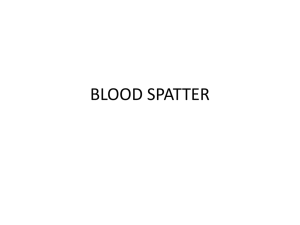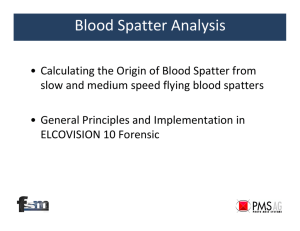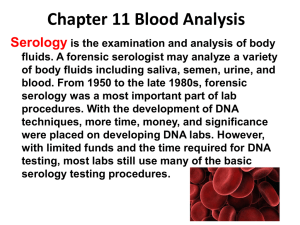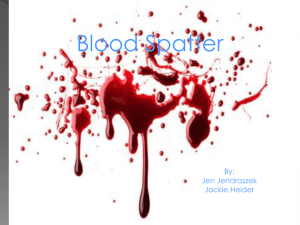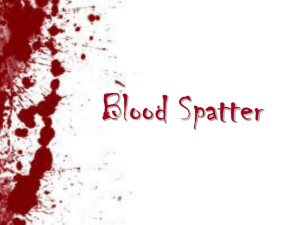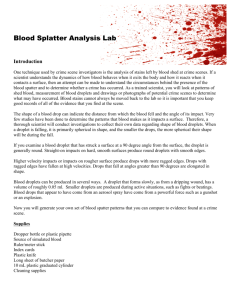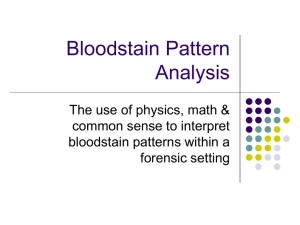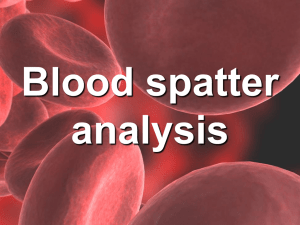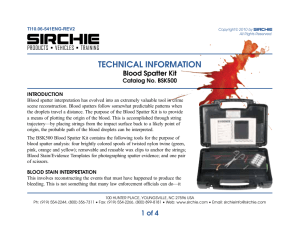Lab 5 – Blood Spatter Analysis
advertisement
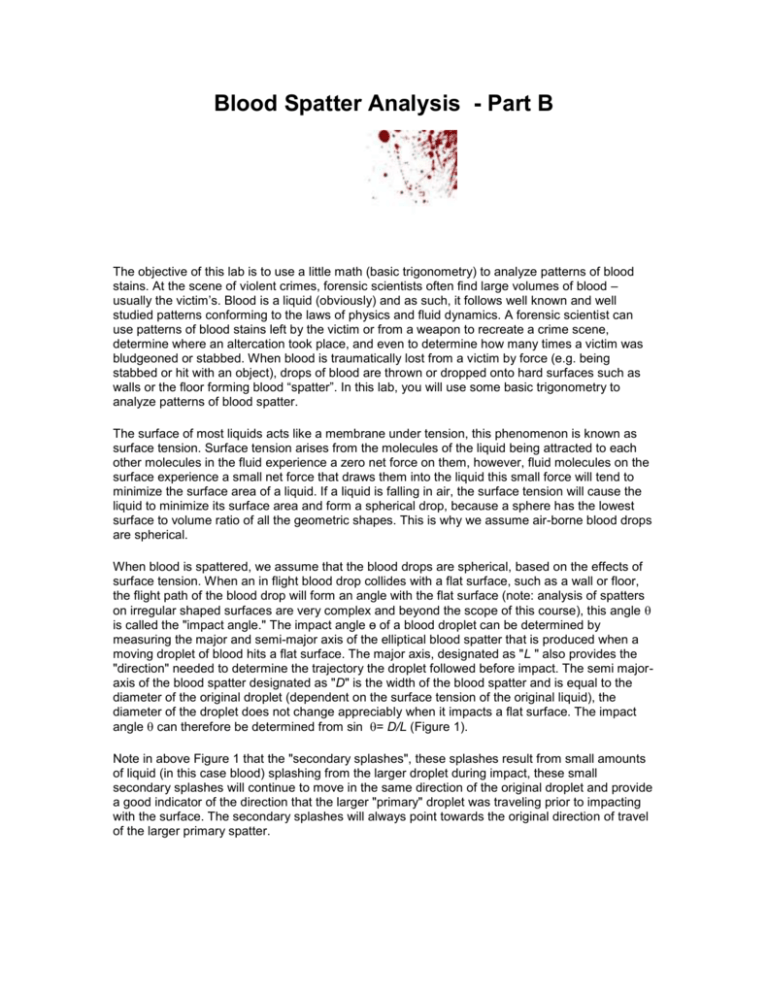
Blood Spatter Analysis - Part B The objective of this lab is to use a little math (basic trigonometry) to analyze patterns of blood stains. At the scene of violent crimes, forensic scientists often find large volumes of blood – usually the victim’s. Blood is a liquid (obviously) and as such, it follows well known and well studied patterns conforming to the laws of physics and fluid dynamics. A forensic scientist can use patterns of blood stains left by the victim or from a weapon to recreate a crime scene, determine where an altercation took place, and even to determine how many times a victim was bludgeoned or stabbed. When blood is traumatically lost from a victim by force (e.g. being stabbed or hit with an object), drops of blood are thrown or dropped onto hard surfaces such as walls or the floor forming blood “spatter”. In this lab, you will use some basic trigonometry to analyze patterns of blood spatter. The surface of most liquids acts like a membrane under tension, this phenomenon is known as surface tension. Surface tension arises from the molecules of the liquid being attracted to each other molecules in the fluid experience a zero net force on them, however, fluid molecules on the surface experience a small net force that draws them into the liquid this small force will tend to minimize the surface area of a liquid. If a liquid is falling in air, the surface tension will cause the liquid to minimize its surface area and form a spherical drop, because a sphere has the lowest surface to volume ratio of all the geometric shapes. This is why we assume air-borne blood drops are spherical. When blood is spattered, we assume that the blood drops are spherical, based on the effects of surface tension. When an in flight blood drop collides with a flat surface, such as a wall or floor, the flight path of the blood drop will form an angle with the flat surface (note: analysis of spatters on irregular shaped surfaces are very complex and beyond the scope of this course), this angle is called the "impact angle." The impact angle ө of a blood droplet can be determined by measuring the major and semi-major axis of the elliptical blood spatter that is produced when a moving droplet of blood hits a flat surface. The major axis, designated as "L " also provides the "direction" needed to determine the trajectory the droplet followed before impact. The semi majoraxis of the blood spatter designated as "D" is the width of the blood spatter and is equal to the diameter of the original droplet (dependent on the surface tension of the original liquid), the diameter of the droplet does not change appreciably when it impacts a flat surface. The impact angle can therefore be determined from sin = D/L (Figure 1). Note in above Figure 1 that the "secondary splashes", these splashes result from small amounts of liquid (in this case blood) splashing from the larger droplet during impact, these small secondary splashes will continue to move in the same direction of the original droplet and provide a good indicator of the direction that the larger "primary" droplet was traveling prior to impacting with the surface. The secondary splashes will always point towards the original direction of travel of the larger primary spatter. Figure 1. Relationship of angle a blood droplet is traveling to the shape of the spatter formed. PROCEDURE: Work in lab groups – The effects of angle on blood spatter. Materials: Several sheets of blank, white paper Simulated blood (about 50-100 ml) 1 disposable pipette Protractor Roll of packing tape Meter stick Ruler You will be making measurements of the diameter D and length L for five individual spatters created at the following impact angles; 15°, 30°, 45°, 60°, 75°, 90°. Set up the target board. Your first drop will be at 90 degrees – dropping vertically onto a board on the floor. For all other angles, use the following procedure: Place your dry erase board against a wall, using a protractor at the top of the board where it meets the wall set the angle formed to 15° and securely tape it to the wall (see Figure 2). Note the angle formed by the board and wall is identical to the angle formed by the board and the trajectory of a blood drop, because the blood drops trajectory is parallel to the wall. Now tape a clean white sheet of paper to the target board and label the bottom right corner with the angle that the board is set at. Use the pipette to suck up some of the blood. Hold the stick 1 meter above the target sheet and gently drop some blood onto the paper, one drop at a time. Do not flick the pipette, or move it rapidly in any way to make the drop release, this could impart a different velocity and direction to the drop (we only want gravity acting on the drop). Repeat making individual spatters on the sheet until you have at least 8 or more good spatters that have not run much, or overlap any other spatters. Note, you only need to measure 5 spatters but it is good to have a few spares just in case. Figure 2. Method of setting up the board using a protractor. After completing the spatters on the sheet carefully remove it from the target board and lay it flat somewhere safe to dry (drying times will vary, but usually the sheets are dry after one hour). Repeat the steps above for: 30°,45°, 60°, 75°, and 90°. When finished you should have blood spatter sheets made at 7 different angles. When the sheets are dry label 5 spatters on each sheet 1 through 5. Using the ruler, carefully measure the width of each spatter (W) and the length of th each spatter (L) (to the nearest 10 of a mm) and write the values down beside the spatter. Next, record your values in your lab notebook for the appropriate angles. Calculate the AOI for each spatter and record the results in your data table. Then calculate the average AOI for each impact angle, and record these results. Glossary of Key Bloodstain Pattern Analysis Terms Angle of Impact: the angle at which a blood droplet strikes a surface Arterial Gushing: the large pattern of blood that is created when blood escapes an artery under pressure; the increase and decrease in blood pressure is apparent Arterial Spurts: large patterns created under pressure, but with less volume and usually more distinctive evidence of blood pressure rising and falling Clot: a mass of blood and other contaminants caused through clotting mechanisms Cast-Off Stains: blood that has been thrown from a secondary object (weapon or hand) onto a target other than the impact site Drop Patterns: characteristic patterns present when blood drips into standing, wet blood Expiratory Blood: blood which is spattered onto a target, as a result of breathing; typically, this occurs when an injury is sustained to the throat, mouth, or airway Impact Site: usually the point on the body that received the blow or applied force, from which the blood was shed Origin: the point in space where the blood spatter came from Parent Drop: the droplet from which satellite spatter originated Projected Blood: blood under pressure that strikes a target Satellite Spatters: small drops of blood that break off from the parent spatter when the parent droplet strikes a target surface Shadowing/Ghosting/Void: a pattern that helps to place an object or body in the scene; normally, the area in question lacks blood even though areas surrounding it show blood Skeletonized Stain: the pattern left when an object moves through a partially dried stain, removing part of the blood, but leaving the outline of the stain intact Spatter: bloodstains created from the application of force or energy to the area where the blood is Spines: the pointed edges of a stain that radiate out to form the spatter Splash: pattern created when a volume of blood in excess of 1 mL strikes a surface at a low to medium velocity Swipe: the transfer of blood onto a target surface by a bloody object that is usually moving laterally Transfer Pattern: the pattern created when a wet, bloody object comes in contact with a target surface, leaving a pattern that has the features of the object making it useful for identifying the object
